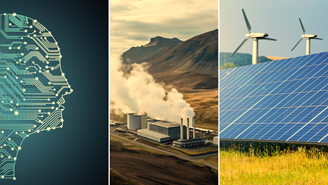There is significant hype associated with the rollout of 5G networks, which is largely tied to the incredible data transfer speeds 5G capable networks can offer. However, speed is only part of the equation. Beyond speed, key attributes of 5G also include lower latency, reduced cost per gigabyte and larger connection volumes. 5G, unlike previous network technology, will be software-defined, enabling networking functionality to be flexible and adaptable over time.[i] As a result, 5G is anticipated to create a new digital backbone to power future infrastructure needs – a topic we explored in Sustainalytics’ report, 10 for 2020: Creating Impact Through Thematic Investing.
With these attributes well suited to accelerate the next phase of industrialization, ‘Industry 4.0.,’ this next phase is expected to increasingly leverage the benefits of machine learning and connected systems to deliver improved operational efficiency and system resiliency.
While 5G’s improved connectivity enables a variety of benefits, designing sustainability focused 5G applications will be key to enabling efficient and resilient infrastructure. This will demand strong technical expertise as well as quality management – two factors that can set companies apart. As investors consider Sustainable Development Goal (SDG) and impact driven investment strategies, companies developing 5G solutions with sustainability as a key value proposition maybe worth considering as part of a portfolio mix.
5G and SDGs
5G can play an instrumental role in supporting a range of SDGs from good health to sustainable infrastructure. One of these goals, SDG 9, which articulates the need to build resilient infrastructure, promote inclusive and sustainable industrialization and foster innovation is expected to be a primary beneficiary of 5G. Specifically, 5G technology is expected to overcome limits of existing wireless technology and enable capabilities required for scaling data-intensive enterprises as well as real time applications, such as remote healthcare administration, industrial automation and smart cities.
Integrating the Physical and Digital
While 4G technology focused on delivering mobile first experiences such as video streaming, 5G is designed to be a consolidated software driven platform that can support critical needs.[ii] Specific applications include enhanced telemedicine, robot assisted surgery, and augmented reality (AR) based tools for industrial processes.
AR based applications are likely to be an important aspect of creating resilient infrastructure as maintenance and repairs can be performed with aid of digital information overlaid on a physical object. For example, Ericsson is testing a solution where 5G enabled AR tool is used to maintain systems and repair defects as it allows a technician to focus on the problem rather than spend time looking for schematics and other relevant data. All that data is already transmitted through a 5G connection in real time as part of the technicians view when utilizing AR based tools.[iii] Such an approach removes certain points of failure and enables a faster way to address a technical issue. If this sounds familiar, it is likely because these types of AR based application has been depicted in many science fiction-based movies and television shows. Similar technology can be applied in all kinds of scenarios where troubleshooting of physical systems is required. This can help support reduced operational down time and increase overall efficiency.
Beyond the Hype
5G is expected to provide a pathway to bridge the gap between the physical and digital spheres. However, it is important to not see all 5G solutions as game changers or those that will support Industry 4.0 and SDG objectives. For investors, differentiating may be challenging early on but a company’s approach to talent and quality management can provide a strong signal as to its ability to execute successfully on a 5G product or solution.
For more information on how Sustainalytics research can help identify outperformers in the 5G space, please contact Moin Syed and see his article in our recent report, 10 for 2020: Creating Impact Through Thematic Investing.
Sources:
[i] https://www.cisco.com/c/en/us/solutions/what-is-5g.html#~faqs
[ii] https://www.qualcomm.com/invention/5g/what-is-5g
[iii] https://www.ericsson.com/en/news/2018/1/5g-manufacturing—tallinn




